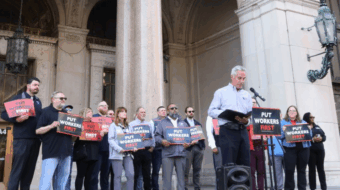This is a sad time in the mining community, with so many recent tragedies. But it’s not enough to mourn. We also have to act.
We need to remember that MSHA is three things. First, it’s a law — the Federal Mine Safety and Health Act of 1977. That law could certainly be improved … but the act is generally pretty good. The agency could do a great deal more if they fully used the authority the act grants them.
Second, MSHA is a group of dedicated, career civil servants who do the day-to-day work of enforcement and standards-setting. Most of the inspectors are miners themselves.
Third, MSHA is a small group of political appointees, both inside the agency and more importantly, in the Office of the Secretary of Labor. Unfortunately, the decisions they make can negate the effectiveness of the law and frustrate the work of the career MSHA staff. Too often those decisions are ideological, poorly informed by actual facts, and seem designed to protect mine operators at the expense of miners.
This forum is appropriately focused on safety in underground coal mines. That’s where 19 of the 21 deaths so far this year occurred. But MSHA is also concerned with health issues, and its jurisdiction also extends to many commodities besides coal, and of course to surface mines.
In 2004, there were 51,000 workers at underground mines, although some of them worked in surface operations like hoists and prep plants. There were 171,000 workers in surface mines.
Coal accounts for about a third of our nation’s miners — 73,000 out of a total of 222,000. Coal is itself split just about evenly between underground and surface miners. The fatalities so far this year have been heavily concentrated in coal, but last year 35 miners died in metal/nonmetal mines, along with 22 in coal. And although safety hazards like explosions and roof falls are critical, in the long run more miners die from health hazards like coal dust, silica and diesel exhaust.
The problems that afflict MSHA enforcement in underground coal mines extend to every part of the agency’s mission. This administration has made it clear that it believes in “voluntary compliance.” Well, we all believe in voluntary compliance, but every mine inspector — indeed every parent — knows that the way you get voluntary compliance is through strict enforcement. You can’t have the one without the other. Yet this administration persists in seeing voluntary compliance and strict enforcement as incompatible. A favorite phrase is that “we have replaced confrontation with cooperation.” The Sago mine could have used a little more confrontation.
So could the iron mines in northern Minnesota and Michigan, where 4,900 of our members work. I asked some of our safety chairs there how they felt about MSHA enforcement. They praised the work of the mine inspectors, but they all said that the penalties were too small to make much difference. The consensus was that the operators see the penalties as a cost of doing business, and a minor one at that.
Let me turn to another example, diesel emissions in underground metal and nonmetal mines. Diesel causes cancer. Levels in some underground mines far exceed levels in any other setting. Working in some mines is like working in the tailpipe of a city bus. MSHA set new standards for “diesel particulate matter,” or DPM, in underground mines early in 2001. The rule was immediately challenged by the mining industry.
The standard set an “interim” limit that was set to go into effect in July of 2002. MSHA began doing inspections on that date, but agreed with the industry not to issue citations for a full year.
Then, last September, the mining industry got an even bigger gift from MSHA. On Jan. 20, a final limit — 60 percent lower than the interim limit — was scheduled to go into effect. Instead, MSHA proposed to delay this limit by five more years.
So far as we know, this is the first time that MSHA or OSHA has attempted to significantly roll back a major health standard. We believe this action violates the law. Section 101(a)(9) of the Mine Act provides that “No mandatory health or safety standard promulgated under this title shall reduce the protection afforded miners by an existing mandatory health or safety standard.”
Lawful or not, the delay will cost lives.
Even the announcement of a proposed delay has already harmed miners. Regulation spurs innovation; deregulation can stifle it. Alternative fuels are one way to reduce diesel emissions. Biodiesel is one such fuel. Another is a proprietary emulsified fuel blend called PuriNOx. However, the company that makes it has decided to exit the business at least temporarily, in part because they now anticipate less of a market in the mining industry, due to the proposed delay.
For our part, the USW will join with our brothers and sisters in the United Mineworkers to vigorously oppose any attempt to weaken protection for miners, underground or surface, and whatever it is they happen to mine.
Michael J. Wright is director of health, safety and environment for the United Steelworkers union. This is an abridged version of testimony at a Feb. 13 congressional forum on mine safety and health organized by House Democrats. The full text is at
www.steelworkers-usw.org/usw/program/content/2734.php.









